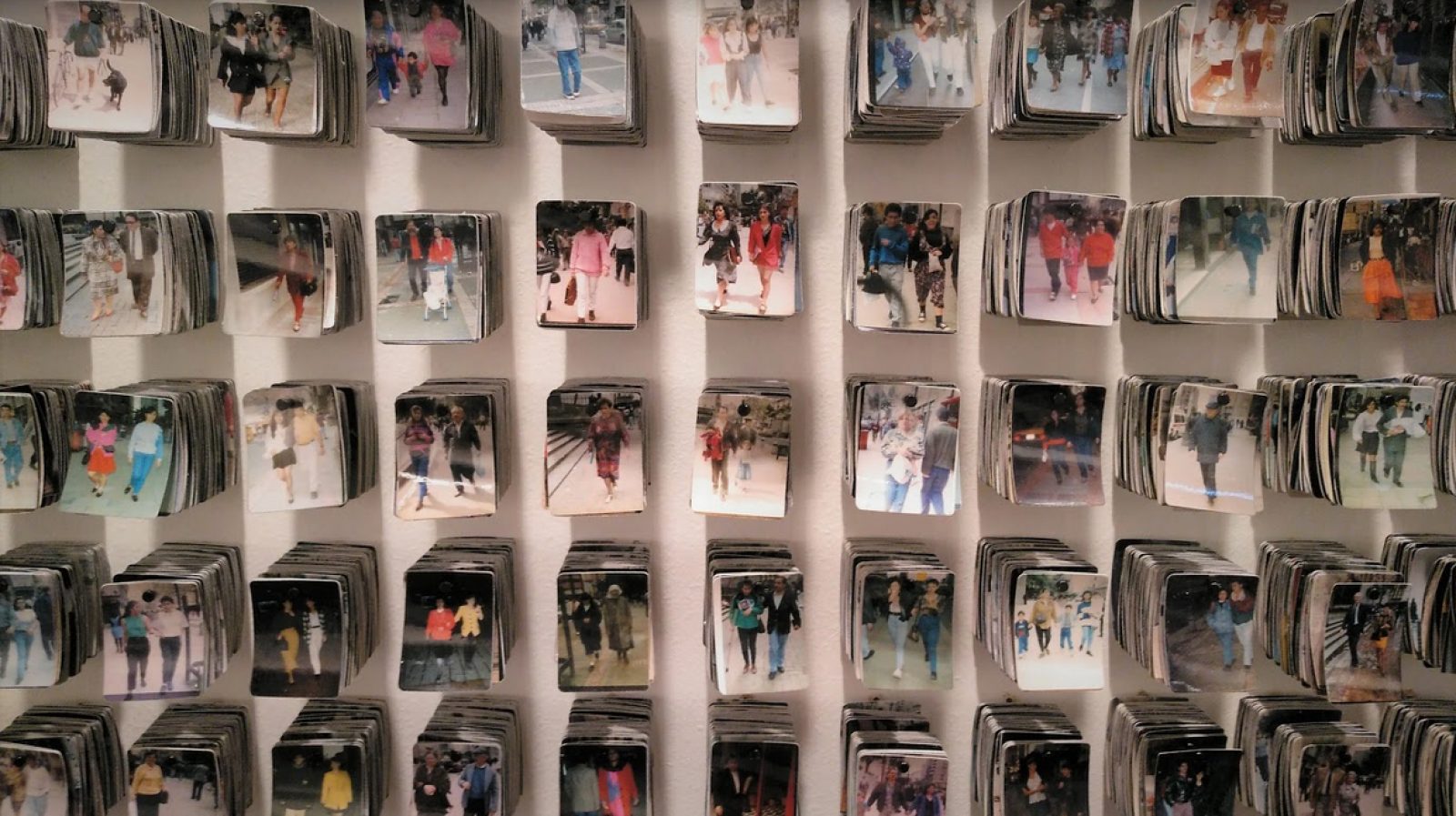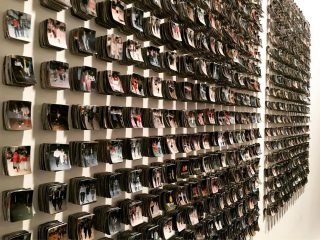
A mediados de los años noventa François Bucher se interesaba intensamente por una serie de fenómenos urbanos de diversa índole. En los trabajos plásticos de esa época – que están marcados por el pensamiento de lo popular, lo pedestre y de la ciudad como tal - se reconoce esa tendencia de los juegos con el tiempo, que lo han ocupado desde su más temprana edad. Instalaciones como Los Jugadores (coautoría con Eduardo Pradilla) o la tesis de grado Auténticas Imitaciones de Réplicas Genuinas presentada en la Casa Wiedemann, y El Marco es la Obra en la Fundación Gilberto Alzate Avendaño, se orientaban por un lado en falsificar realidades, en transmutar lo prosaico en lo poético, y en presentar la ciudad en sus propios términos, como una serie de ready mades urbanos que debían ser rescatados del olvido mediante dobleces ingeniosos . Un casino de lujo anacrónico del centro de Bogotá se convertía así en el reflejo de un cuento de Borges, Los Jugadores, y las carteleras de paño verde de los clubes sociales se convertían en lienzos donde habrían de jugarse múltiples juegos barrocos con la realidad y sus dobles, Auténticas Imitaciones de Réplicas Genuinas.
Uno de esos juegos se realizó con los fotógrafos callejeros de la carrera séptima entre calles 20 y 24. En una foto idéntica a la otra aparecía Bucher con una joven amiga y en la siguiente, solo, en la misma posición, vestido de la misma manera, pero con variaciones que mostraban el paso del tiempo. Hay varios ejemplos de experimentos de este tipo.
Bucher se percató que, más o menos en el año 94, se cerraba el negocio principal de fotógrafos callejeros – de nombre Macondo – y decidió comprar el archivo de cientos de miles de imágenes que comprendían al menos dos décadas de la historia gráfica espontánea de Bogotá. Durante 24 años el archivo ha permanecido guardado en un deposito y solo ahora, en 2017, se produce la primera versión de una obra basada en esas fotos de gente congelada, en su caminar hacia la cámara, captadas en un instante furtivo, absolutamente aleatorio.
El archivo Macondo (la curva del tiempo cero) 1994 – 2017 se liga a trabajos más recientes de Bucher, al tiempo que retoma intereses anteriores. La Duración del presente, notas sobre la frecuencia, obra de varias encarnaciones entre 2012 y 2016 es una clara referencia para este trabajo. El archivo Macondo… es una obra de dimensiones variables que consiste en módulos de 384 casillas, basados en la extrapolación que hace el genial narco nauta Terence Mckenna de un algoritmo deducido de una tirada clásica del juego de adivinación I Ching. Esta tirada específica se llama “Rey Wen”. A partir de ese algoritmo Mckenna determina una ‘forma del tiempo’ y con ella puede determinar ciertos momentos de ‘novedad’ en una duración de cualquier expansión. Entre todos los lugares de novedad que están en la curva hay uno que es el de una novedad absoluta: el momento de una singularidad. La obra utiliza este principio para tirarle la suerte a una pequeña sección del Archivo Macondo de alrededor de 26,000 fotos. Algunas fotos quedan visibles en la superficie, y cada una de ellas oculta cientos de otras fotos, tomadas en otros instantes azarosos, en el Bogotá de los años ochenta. Gracias a que el algoritmo de Mckenna produce una locación singular e irrepetible, hay una sola foto que queda seleccionada como el presente, de entre todos los demás presentes. Así el tiempo queda representado en una topografía de fotos apiladas en torres, cuya cima absoluta indica un único instante presente rescatado del olvido; y que ha sido seleccionado por una contingencia enmarcada en el orden del I Ching. Este sistema adivinatorio tiene a su vez, en su seno números que van desde la descripción de los ciclos lunares hasta el de la “Precesión de los equinoccios”, - el ciclo de 26,000 años -. Esta tirada de suerte, con el naipe de una colección gigante de instantes secretos, sucedidos en una zona restringida del centro de Bogotá, termina funcionando como un oráculo para cualquier otro tiempo y cualquier otro espacio; porque ha sido ordenado en la estricta observancia de un sistema híper-coherente que refleja el orden cósmico, aquel que el I Ching a su vez refleja.
--
During the mid-nineties, François Bucher was intensely interested in a series of urban phenomena. In the artworks from this period – which are marked by an interest in the city of Bogotá – there is a fixation on relativizing time, an interest that had been present from an early age. Installations like Los Jugadores The Players (co-authored with Eduardo Pradilla) or his BFA thesis Auténticas Imitaciones de Réplicas Genuinas True Imitations of Genuine Replicas presented in Casa Wiedemann, as well as El marco es la obra, The Frame is the Artwork shown at Fundación Gilberto Alzate Avendaño, were all dealing with deceptive realities and misleading time sequences; they sought among other things to transform the prosaic into the poetic. All these works had an idea in common, that of “presenting the city in its own terms, through its own self-generated images and words”. This was also the case in a series of urban ready-mades: objects that had been rescued from oblivion through re-contextualizing tricks and folds.
A casino of out-dated luxury in the centre of Bogotá was accordingly converted into a reflexive game on the oeuvre of Jorge Luis Borges - Los Jugadores, The Players - and the classic green bulletin billboards from high society social clubs mutated into strange canvases in one of Bucher’s exhibitions - Auténticas Imitaciones de Réplicas Genuinas, True Imitations of Genuine Replicas-. Multiple baroque games were played in this way with reality and its doubles, as if the world could be perceived as a series of infinite falsifications. One of these games was realised by using the now obsolete trade of the street photographers. In one photo, that looked identical to another, Bucher appeared with a young friend, but in the adjacent picture he was alone in the exact same position, dressed in the same way, but with variations that revealed - for the keen observer - that three years had gone by in the lapse between the two pictures. There are various other examples of this type of artifices.
In approximately 1994 Bucher became aware that they were closing the shop where customers had traditionally claimed and purchased the pictures taken by street photographers in the city centre. The now obsolete firm – which had gone by the name Foto Macondo – had succumbed to the widespread use of digital cameras. Bucher decided to buy the entire archive of hundreds of thousands of images, which comprised at least two decades of this spontaneous “graphic History” of Bogotá. For 24 years, the archive was kept in a basement and it was only in 2017 when Bucher decided to create an artwork based on these pictures of city centre walkers, frozen in time, strolling towards the camera, captured in a random instant. Archivo Macondo (La Curva del tiempo cero) 1994 – 2017, The Macondo Archive (Time wave zero) 1994 - 2017 is related to Bucher’s past works and more recent series of works such as La duración del presente (notas sobre la frecuencia), The Duration of the Present (Notes on Frequency), a body of work which comprises projects made between 2012 and 2016. Archivo Macondo, The Macondo Archive is an artwork that consists of a grid with 384 positions, based on an algorithm that Terence Mckenna inferred from the Chinese divination game I Ching. The brilliant psychedelic mind of Terence McKenna was able to extract a curve that he called Time wave zero from the oldest arrangement of the I Ching - the ‘King Wen’ sequence. From this algorithm, Mckenna determined a ‘form of time,’ which points to specific ‘novelty’ moments within any duration. Amongst all the novelty points in the curve, there is an absolute novelty; that may be called its singularity.
In Bucher’s artwork a selection is made from the Archivo Macondo, The Macondo Archive: all of the pictures where people are walking towards the camera. Only a very small percentage of the 26,000 selected photos are visible in each position of the grid, while dozens of other photos remain hidden in every location of the grid. The photos spiral downwards from the centre; a centre that is in fact equivalent to the singularity in the Time wave zero. Its position signals - in this new context - to the concept of the most present tense of all present tenses. The randomness of what is shown and what is hidden is both a reflection on the haphazardness of the moment when the shutter of the camera opened, but also a musing on the nature of any process of divination that hides the cards of the deck revealing only the ones that were chosen by chance. Time is therefore represented in a landscape of photos stacked in towers, whose top images indicate particular present tenses rescued from oblivion.
The I Ching contains numbers that range from the description of lunar cycles to the "Precession of the equinoxes" - a cycle of 26,000 years. In this way the giant collection of secret instants, from a restricted area of downtown Bogotá, ends up working like an oracle for any other time and any other space. The main point being that the archive has been ordered in strict observance of a hyper-coherent system, a kind of matrix that holds the numbers of an invisible cosmic order.
